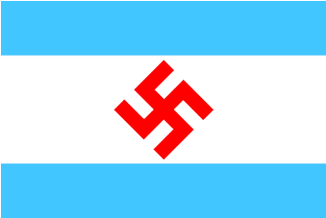
Last modified: 2014-04-27 by zoltán horváth
Keywords: oirot republic | swastika |
Links: FOTW homepage |
search |
disclaimer and copyright |
write us |
mirrors
 Roberto Breschi, 9 Jan 2010
Roberto Breschi, 9 Jan 2010
In 1918, the educated Altaians began to use the ethnonym "Oirot" to underline their glorious origins. The Oirot ideology was eloquently articulated by V.I.Anuchin at the various meetings leading to the Congress of Altai People in Ulale. His nationalistic idea was to create an independent Greater Oirot Republic uniting the inhabitants of both, Russian and Mongolian Altai, Uriankhai (Tuva) and the Chinese Dzungaria as one tribe - the great Oirot Nation - the "Kizhi", rediscovering its historical roots, and confirming its right to the political self-determination. Proclaiming the Oirat Republic, the Congress of Ulale formed a nucleus of the Greater Oirat Republic on the territory of the Upper Altai District with the hope it would be soon encompassing the other people of the area, that it would mobilize all the Altaic people to fight for their independent statehood.
The first flag of the Oirot Republic was white, framed in blue along
all the edges - the national colors of Altai.
The state had a difficult time to function as the area was occupied by
the "White" forces of Admiral Kolchak,
who didn't look favorably at any attempts of separatism from "Mother" Russia.
Chrystian Kretowicz, 9 Jan 2010
 Roberto Breschi, 9 Jan 2010
Roberto Breschi, 9 Jan 2010
When the Bolsheviks prevailed in the Altai region, there was a second try to establish the Oirot Republic. In 1921, at Biysk, the republic was proclaimed again, and the tri-band of blue, white, and blue, with the red swastika in the center, was hoisted. The white band was wider than the blue ones and the swastika is a solar symbol commonly used by many nations in that part of Asia. It wasn't a successful attempt at independence, but at the regional Soviet meeting at Tomsk, on July8, 1921, the re-establisment of the Oirot Republic was, at least, discussed. The meeting was attended by some leaders of the Oirot nationalism - Anichin and Konzychakov.
They tried to resurrect the idea of the "Oirot State" tn the Soviet conditions, but the final decision was in the hands of Moscow. Konzychakov, who was a member of the Communist Party and had some influence on the decision, postulated on September 5, 1921 to the Soviet of the People's Commissars the need to combine the Altai, Biysk, Kuznetsk, Minusinsk and Achinsk counties (rayons) in the eventual Oirot Republic. The draft of the statehood, presented in Moscow, included the territory populated by the Altais, Khakass, Kumandins, Teleuts, Telangits, Tatars and some Kalmyks, all related ethnically. The nationalists efforts on the attainment of the statehood have fallen short of the expectations when the Soviet government decided finally on the formation of the national territorial units. On June 1, 1922, the Oirot Autonomous Oblast' was proclaimed, renamed as the Gorno-Altaisk Autonomous Oblast' on January 7, 1948.
On October 25, 1990 it was upgraded to the status of the Gorno-Altaisk Autonomous Soviet Socialist Republic within the Russian Socialist Federated Soviet Republic. On July 3, 1991 it became the Gorno-Altaisk Soviet Socialist Republic within Russia, changing its name again in May, 1992 to the Republic of Gorno Altai, and finally, it become on December 12, 1993 what it is today - - Altai Republic.
Roberto Breschi quotes as his sources: